Magic Rings
Aug 2, 2012
 Our son John Stein and Bonnie Strelitz were married last weekend in Seattle. I don't remember the rings sparkling quite this much, but the sun was smiling and the stars all a-whispering their warmest good wishes.
Our son John Stein and Bonnie Strelitz were married last weekend in Seattle. I don't remember the rings sparkling quite this much, but the sun was smiling and the stars all a-whispering their warmest good wishes.
Aug 2, 2012
 Our son John Stein and Bonnie Strelitz were married last weekend in Seattle. I don't remember the rings sparkling quite this much, but the sun was smiling and the stars all a-whispering their warmest good wishes.
Our son John Stein and Bonnie Strelitz were married last weekend in Seattle. I don't remember the rings sparkling quite this much, but the sun was smiling and the stars all a-whispering their warmest good wishes.
Aug 3, 2012
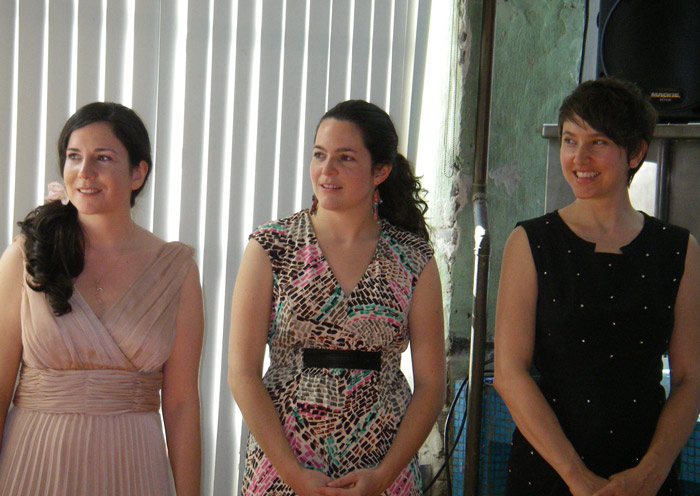 Before last weekend's wedding, Bonnie the bride rehearsed with her attendants: her sister Caroline and longtime friend Katie. After the wedding, John the groom goofed around with his attendants: his brothers Ted, Joe, Allen, and Hank.
Before last weekend's wedding, Bonnie the bride rehearsed with her attendants: her sister Caroline and longtime friend Katie. After the wedding, John the groom goofed around with his attendants: his brothers Ted, Joe, Allen, and Hank.
Aug 4, 2012
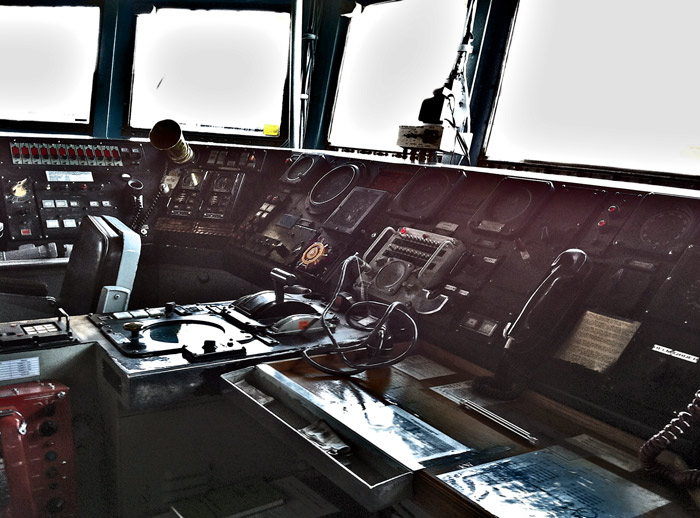 On the bridge of the navy frigate USS Ingraham, the tiny gold-colored wheel near the center of the picture, with spokes protruding from the rim, is what actually steers the ship. As the instrumentation suggests, American naval frigates were designed in the 1970s, back when phones were attached to the wall by curly cords. Frigates are gradually being decommissioned--sold off to countries looking for cheap warships--but meanwhile they are still very much in active service, accompanying aircraft carriers around the world or sailing independently on anti-piracy or anti-smuggling missions.
On the bridge of the navy frigate USS Ingraham, the tiny gold-colored wheel near the center of the picture, with spokes protruding from the rim, is what actually steers the ship. As the instrumentation suggests, American naval frigates were designed in the 1970s, back when phones were attached to the wall by curly cords. Frigates are gradually being decommissioned--sold off to countries looking for cheap warships--but meanwhile they are still very much in active service, accompanying aircraft carriers around the world or sailing independently on anti-piracy or anti-smuggling missions.
The Ingraham recently returned from a six-month deployment in the eastern Pacific near Panama, where its helicopters chased down small boats thought to be smuggling drugs to North America. The picture below shows family and friends standing on the flight deck during a recent tour of the ship conducted by Ensign Al, the Ingraham's electrical engineer who also serves as public information officer. Two helicopters operate from the flight deck. The ship in the background is a destroyer, slightly bigger than a frigate, which is also based at Naval Station Everett on Puget Sound north of Seattle.
Aug 5, 2012
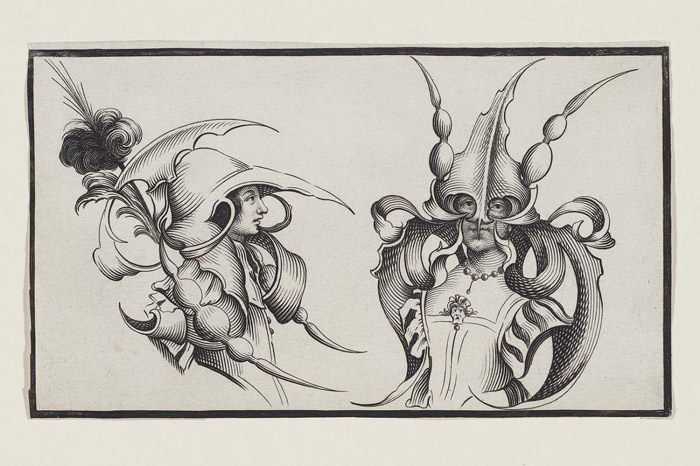 Back in the year 1638, in the colonies that would eventually become the U.S. of A., Massachusetts Puritans were busily banning Anne Hutchinson and Swedish Lutherans were building a settlement in Delaware. But in Paris, on the other hand--ah, Paris--the French fashion industry was already edgy and extravagant, as evidenced by this illustration of headdress designs, published as part of a collection titled Ouvrage Rare et Nouveau Contenant Plusieurs Desseins de Marveilleuse Recreation sous Diverses Caprices et Gentilesses.
Back in the year 1638, in the colonies that would eventually become the U.S. of A., Massachusetts Puritans were busily banning Anne Hutchinson and Swedish Lutherans were building a settlement in Delaware. But in Paris, on the other hand--ah, Paris--the French fashion industry was already edgy and extravagant, as evidenced by this illustration of headdress designs, published as part of a collection titled Ouvrage Rare et Nouveau Contenant Plusieurs Desseins de Marveilleuse Recreation sous Diverses Caprices et Gentilesses.
Aug 7, 2012
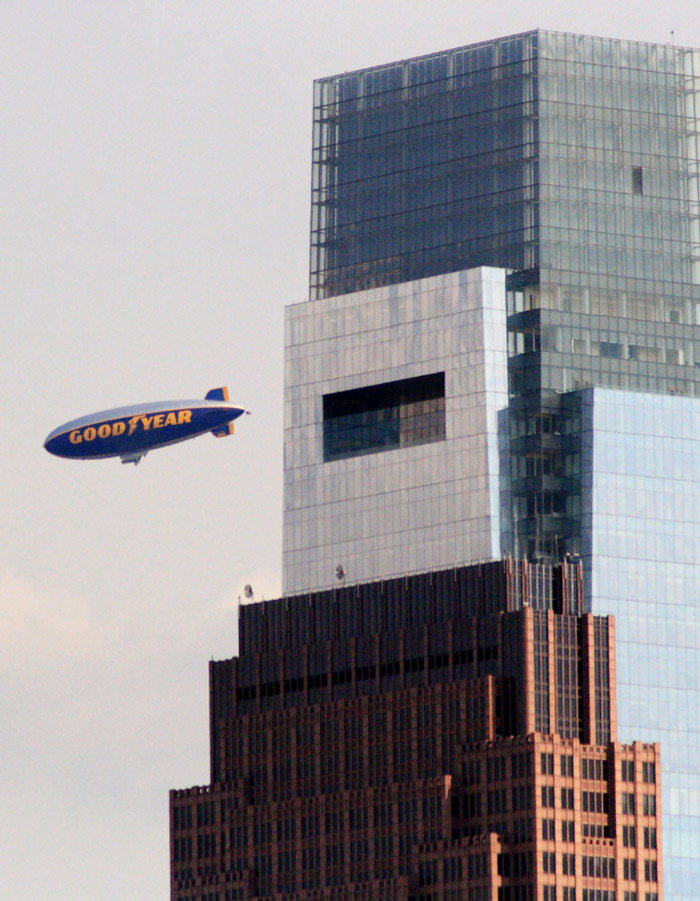 The blimp sails past the Comcast Center, tallest building in Philadelphia.
The blimp sails past the Comcast Center, tallest building in Philadelphia.
Aug 8, 2012
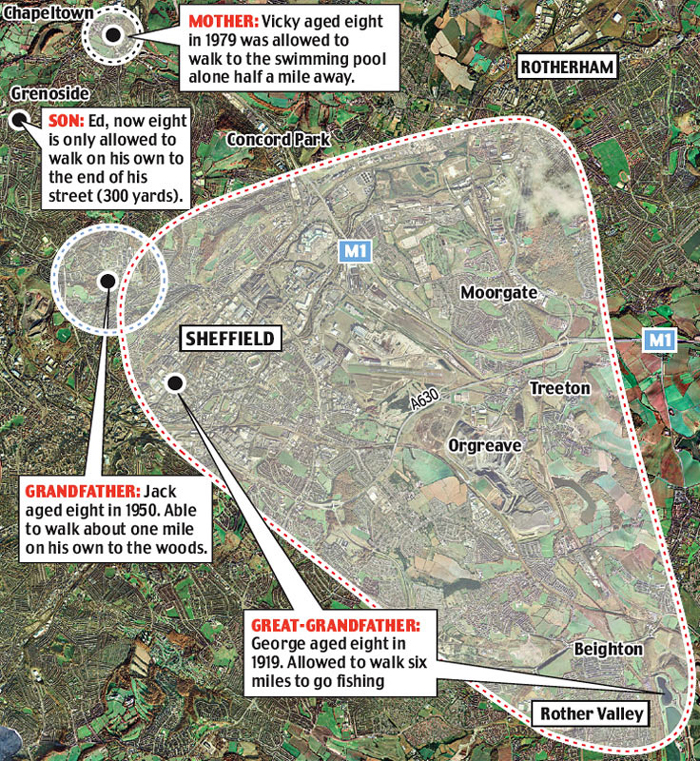 In 1919, when George Thomas was an eight-year-old growing up in the town of Sheffield in northern England, he and his brothers and friends felt they owned the streets of Sheffield and the fields and forests all around. Their parents didn't mind when they wandered off on adventures of their own devising; even at the young age of eight, he often walked six miles to a fishing pond.
In 1919, when George Thomas was an eight-year-old growing up in the town of Sheffield in northern England, he and his brothers and friends felt they owned the streets of Sheffield and the fields and forests all around. Their parents didn't mind when they wandered off on adventures of their own devising; even at the young age of eight, he often walked six miles to a fishing pond.
In 1950, when George Thomas's son-in-law Jack Hattersley was eight years old in Sheffield, children still routinely walked long distances from home unsupervised. Almost daily, Jack walked a mile to play with his friends (unsupervised) in the woods.
But by 1979, when Jack Hattersley's daughter Vicky was eight years old in Sheffield, children stuck closer to home. Vicky grew up in a suburban subdivision, which she never left except in cars driven by her parents or her friends' parents. Still, she was allowed to walk or ride her bike by herself as far as about half a mile through the neighborhood to her friends' homes or to the swimming pool. And like her father and grandfather, she walked to school every day.
By 2007, when Vicky's son Edward Grant turned eight, unscripted and unsupervised childhood wandering was a thing of the past. Ed has a bike, but to ride it he and his parents travel by car to safe bike paths. His mother drives him to school. He is allowed to walk by himself to the end of his block, about 300 yards, but his parents say he never wants to do that because no other children in the neighborhood are allowed out by themselves to play.
Like many eight-year-olds nowadays, Ed basically stays in his house except when his parents drive him somewhere. This is not a miserable situation for him; unlike his great-grandfather, whose childhood home was cramped and crowded and unadorned with childhood playthings, Ed has a room of his own at home, with plenty of toys and electronic diversions. Since he's never known the freedom to wander that was treasured by generations of children past, he doesn't seem to miss it.
His mother, grandfather, and great-grandfather mourn the loss for him. They are nostalgic for this aspect of their own childhoods. They suspect that some of the fears leading parents to keep children so entirely caged nowadays are overblown. But still, societal norms have become so fiercely hostile to the very idea of letting children loose that no challenge seems possible. It is their duty to keep Ed safe and supervised, even if the consequence is that his childhood is being spent in a gilded prison.
Wonder what will happen to Ed's children?
Aug 9, 2012
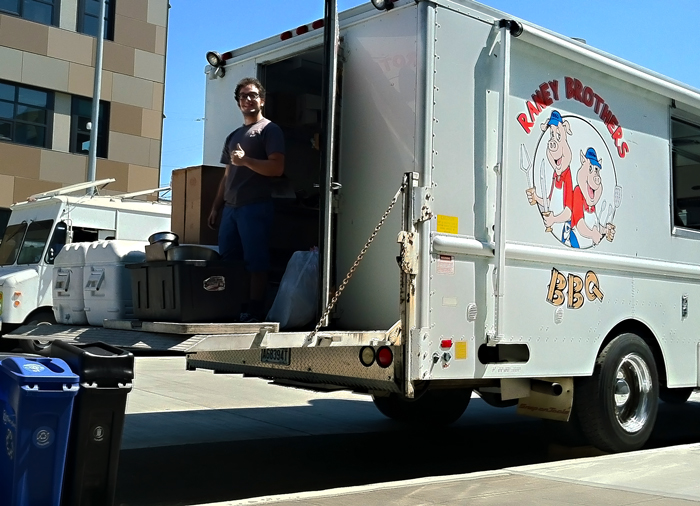 Hank interrupts his cleanup work to give us a thumbs-up from the back of the Raney Brothers BBQ truck in downtown Seattle.
Hank interrupts his cleanup work to give us a thumbs-up from the back of the Raney Brothers BBQ truck in downtown Seattle.
Aug 10, 2012
 At the feet of the fiddler in this picture is his open violin case, with a hat in it. He is riding the Washington State ferry that crosses Puget Sound between Edmonds and Kingston, just north of Seattle. I don't know if he's trying to make a living this way or just hoping to pull in a few bucks or simply earning back his ferry fare as he rides the water. It's also possible that he's doing this because he lost a bet. Whatever, this crossing had a soundtrack that I used to believe was better suited to trains than to boats: Foggy Mountain Breakdown and Orange Blossom Special.
At the feet of the fiddler in this picture is his open violin case, with a hat in it. He is riding the Washington State ferry that crosses Puget Sound between Edmonds and Kingston, just north of Seattle. I don't know if he's trying to make a living this way or just hoping to pull in a few bucks or simply earning back his ferry fare as he rides the water. It's also possible that he's doing this because he lost a bet. Whatever, this crossing had a soundtrack that I used to believe was better suited to trains than to boats: Foggy Mountain Breakdown and Orange Blossom Special.
(Reposted from a 7 November 2008 posting to an antediluvian ancestor of this blog.)
Aug 12, 2012
 A peregrine falcon takes in a February sunrise from the railing of an apartment balcony in Chicago.
A peregrine falcon takes in a February sunrise from the railing of an apartment balcony in Chicago.
Aug 13, 2012
 The Romans found gold here at Dolaucothi in south Wales, near the village of Pumsaint, in 74 A.D. During five centuries of mining, Roman engineers developed hydraulic works, then a large open pit mine, and eventually vast underground operations, complete with dewatering channels and pumps to keep deep mine tunnels from flooding.
The Romans found gold here at Dolaucothi in south Wales, near the village of Pumsaint, in 74 A.D. During five centuries of mining, Roman engineers developed hydraulic works, then a large open pit mine, and eventually vast underground operations, complete with dewatering channels and pumps to keep deep mine tunnels from flooding.
Beginning in the nineteenth century, the British made several tries at reopening the mine, but they gave it up for good in 1938, defeated not so much by lack of gold as by surfeit of water underground. Today, Dolaucothi is a national park, offering mine tours and archaeological exhibits of Roman artifacts found onsite.
Aug 14, 2012
 Why comment?
Why comment?
Aug 15, 2012

Aug 16, 2012
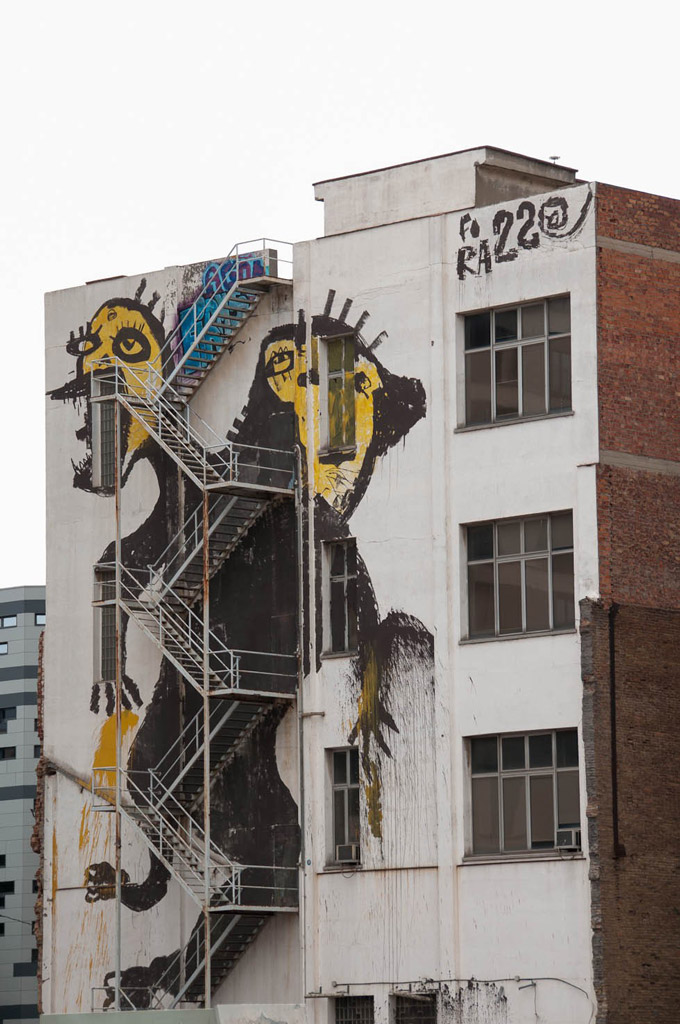 The writing on the wall in Barcelona, as noted by Norwegian photographer Jørgen Stensrud.
The writing on the wall in Barcelona, as noted by Norwegian photographer Jørgen Stensrud.
Aug 16, 2012
 World's End is the name of a state park in Pennsylvania, a knob in the marshland near Boston, an off-the-map locale for the weakest sequel to Pirates of the Caribbean, and a major site of action for World of Warcraft. But the World's End that this kayaker is nearing is the southern end of Tjøme Island, near the outlet of Norway's Oslo Fjord.
World's End is the name of a state park in Pennsylvania, a knob in the marshland near Boston, an off-the-map locale for the weakest sequel to Pirates of the Caribbean, and a major site of action for World of Warcraft. But the World's End that this kayaker is nearing is the southern end of Tjøme Island, near the outlet of Norway's Oslo Fjord.
Aug 18, 2012
 Just west of Toronto, in the fast-growing suburban city of Mississauga, these two condo towers have scratched the sky in flat-out defiance of latter-day suburban trends: they are not boxy, they are not real-estate development disasters, and not a one of their 800-plus condo units is exactly like any other in size or shape.
Just west of Toronto, in the fast-growing suburban city of Mississauga, these two condo towers have scratched the sky in flat-out defiance of latter-day suburban trends: they are not boxy, they are not real-estate development disasters, and not a one of their 800-plus condo units is exactly like any other in size or shape.
In 2005, Mississauga's mayor announced an international design competition for a single 54-story tower at the site, to be known as Absolute World. In 2007, the winning architect was announced, chosen by the voting public from among six finalists selected by a panel of Canada's leading architects and planners. The winner was Yasong Ma, of MAD Architectural Design Studio in Beijing. Almost immediately, the spiraling, curvaceous tower was nicknamed Marilyn Monroe.
When condominiums in Marilyn Monroe were offered for pre-construction sale, almost all were under contract within 24 hours. The developers quickly announced a second, companion tower, also spiraling and asymmetric but a bit more buxom, so as to accommodate a few more units. This second tower sold out within about a month.
Aug 21, 2012
 Philadelphia is standing in for New York City this summer during the filming of Paranoia, a thriller starring Harrison Ford and Liam Hemsworth and directed by Robert Luketic (Legally Blonde).
Philadelphia is standing in for New York City this summer during the filming of Paranoia, a thriller starring Harrison Ford and Liam Hemsworth and directed by Robert Luketic (Legally Blonde).
For example: here in Center City Philadelphia, on 16th Street near Locust, is a New York City taxicab, in a line of cars all bearing New York plates. Look closely, and perhaps you can make out the cars' back-up lights all lit up; this line of traffic was in fact moving in reverse, preparing for the filmmakers to take one more take.
A few weeks ago, this same outfit took over the Rittenhouse Square restaurant Twenty Manning for a day of shooting. Our own Joe Stein, who worked there, was told to take the day off but then called in early the next day to help clean up the mess that Hollywood had left behind.
Some of the people in this photo are extras who were supposed to be walking in or around this intersection as the scene was shot and reshot. Others of the people seen here are Philadelphians who just happened by, and who were supposed to be shooed out of camera range. I couldn't tell the two types of people apart, but the bossy folks wearing orange vests seemed very certain who was who. Somebody yelled at me and my mother to get out of the picture, and insulting as that seemed, we left without putting up an argument.
Aug 22, 2012
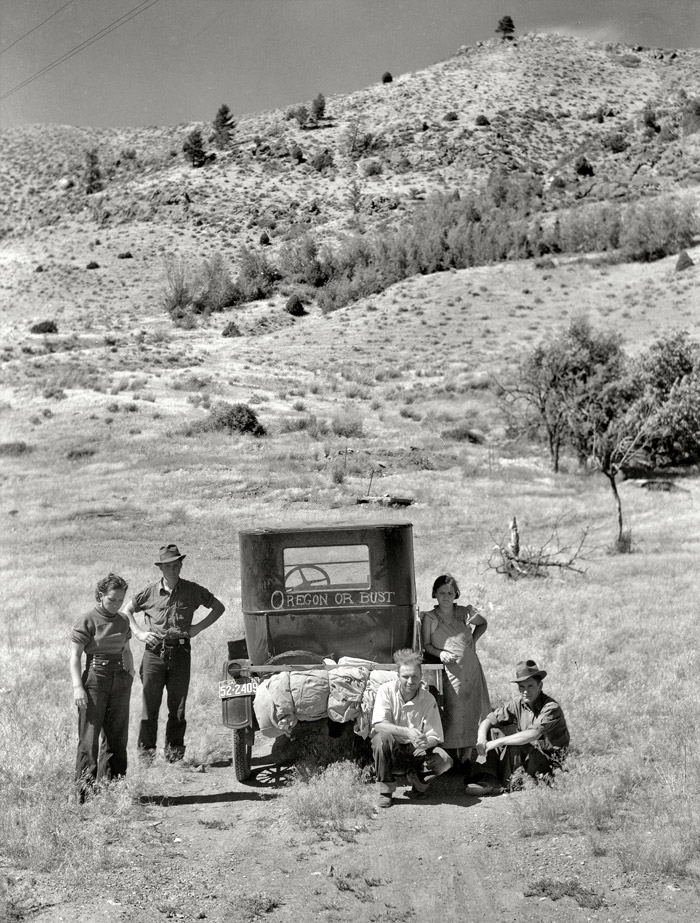 The only summer in American history drier than this summer of 2012 was 1936, the time of the Dust Bowl. In South Dakota, home to the family of Vernon Evans, pictured here, the drought was compounded by a grasshopper plague. The crop failed, the bank took the farm, and there were no jobs to be had. "You couldn't even buy a job," according to Evans.
The only summer in American history drier than this summer of 2012 was 1936, the time of the Dust Bowl. In South Dakota, home to the family of Vernon Evans, pictured here, the drought was compounded by a grasshopper plague. The crop failed, the bank took the farm, and there were no jobs to be had. "You couldn't even buy a job," according to Evans.
They had $54, and no idea how they were going to get by, when they piled into their Model T and headed west. The first day they only made six miles before breaking the crankshaft; fortunately, a nearby farmer had a yard full of dead Model Ts; he told the Evanses to find themselves a crankshaft and take it, no charge.
They were on the road again a day later and made good time for the next few days, averaging about 200 miles a day till they reached the outskirts of Missoula, Montana, where they passed a car at the side of the road with a man sleeping in it. They honked at him, "just having a good time." The man woke up quickly, started his car, and chased them down, waving frantically for them to pull over. They thought he was a cop turning them away from Missoula; many communities had posted guards to try to keep the Dust Bowl migrants out of town.
"Well, here's where we go back home," the Evanses said to one another. They had $16 left.
But the cop turned out to be Resettlement Administration photographer Arthur Rothstein, who introduced himself, explained that the sign on the back of their car had caught his eye, and asked if he could take a picture. They told him they were headed for Yakima, Washington, hoping to arrive in time to find work harvesting hops.
Rothstein snapped eight poses there on the road to Missoula, which the family recalled seeing in newspapers and magazines a few months later, when they were newly settled in Oregon, working for the railroad.
Aug 23, 2012

Aug 24, 2012
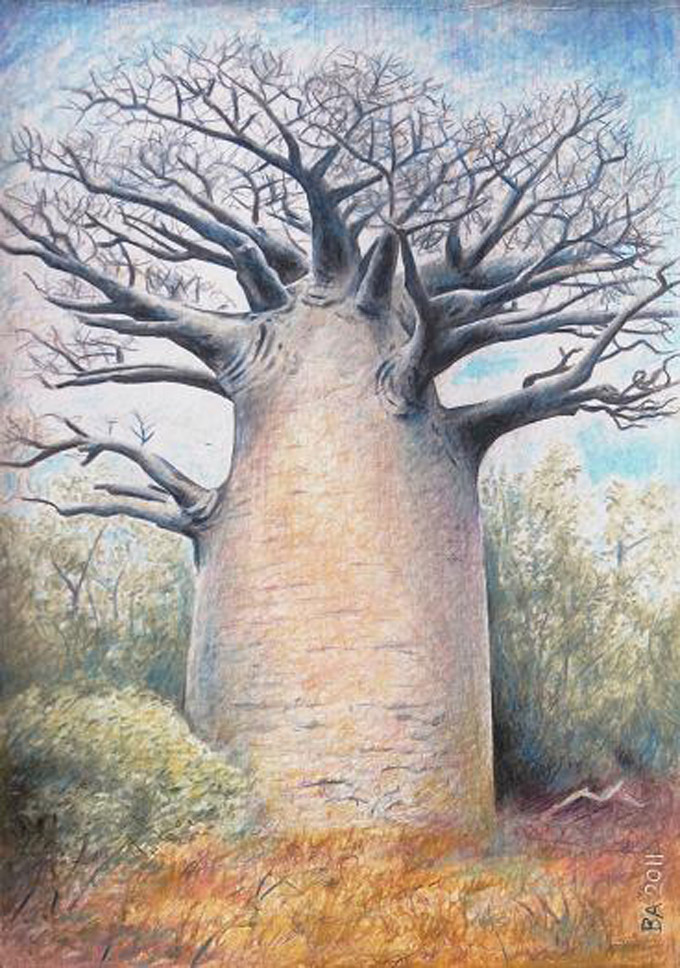
Aug 25, 2012
 Among the finalists for this year's National Geographic photo competition is this shot of a baobab grove near the town of Morondava in western Madagascar.
Among the finalists for this year's National Geographic photo competition is this shot of a baobab grove near the town of Morondava in western Madagascar.
Baobabs are unusual trees, with swollen trunks that store water, allowing them to survive long periods of drought. Some species of baobab can grow without soil, drilling their roots directly into bare limestone, and some are so tolerant of salt water they can grow within a few feet of the ocean.
The trees in this picture are believed to be many thousands of years old, but baobab wood does not produce annual growth rings, making age calculations rather speculative.
Baobabs produce fruit with a flavor that is described as very tart and grapefruit-like. The fruit pulp is a common ingredient in many regional dishes and is being studied by international food companies as a possible additive to Western-style foods and beverages, such as fruit smoothies. "It brings an interesting and exotic flavor," said PhytoTrade spokesperson Lucy Welford. "Now that we've had a lot of interest in Europe, I think there might be a knock-on effect in the U.S."
Aug 26, 2012
 The illustration above and the passage below, which together almost certainly constitute the final word on baobabs, come from Antoine de Saint-Exupéry's The Little Prince (1943). The prince had found himself on a small, distant planet, about the size of an asteroid, which was infested with the seed of baobabs.
The illustration above and the passage below, which together almost certainly constitute the final word on baobabs, come from Antoine de Saint-Exupéry's The Little Prince (1943). The prince had found himself on a small, distant planet, about the size of an asteroid, which was infested with the seed of baobabs.
A baobab is something you will never, never be able to get rid of if you attend to it too late. It spreads over the entire planet. It bores clear through it with its roots. And if the planet is too small, and the baobabs are too many, they split it in pieces . . .
"It is a question of discipline," the little prince said to me later on. "When you've finished your own toilet in the morning, then it is time to attend to the toilet of your planet, just so, with the greatest care. You must see to it that you pull up regularly all the baobabs, at the very first moment when they can be distinguished from the rosebushes which they resemble so closely in their earliest youth. It is very tedious work," the little prince added, "but very easy."
And one day he said to me: "You ought to make a beautiful drawing, so that the children where you live can see exactly how all this is. That would be very useful to them if they were to travel some day. Sometimes," he added, "there is no harm in putting off a piece of work until another day. But when it is a matter of baobabs, that always means a catastrophe. I knew a planet that was inhabited by a lazy man. He neglected three little bushes . . ."
So, as the little prince described it to me, I have made a drawing of that planet. I do not much like to take the tone of a moralist. But the danger of the baobabs is so little understood, and such considerable risks would be run by anyone who might get lost on an asteroid, that for once I am breaking through my reserve. "Children," I say plainly, "watch out for the baobabs!"
My friends, like myself, have been skirting this danger for a long time, without ever knowing it; and so it is for them that I have worked so hard over this drawing. The lesson which I pass on by this means is worth all the trouble it has cost me.
Perhaps you will ask me, "Why are there no other drawing in this book as magnificent and impressive as this drawing of the baobabs?"
The reply is simple. I have tried. But with the others I have not been successful. When I made the drawing of the baobabs I was carried beyond myself by the inspiring force of urgent necessity.
Aug 27, 2012
Kaspar Maldre, looking wise beyond his weeks.
Aug 29, 2012
 This artwork is from the lid of a box of fireworks. USA! USA!
This artwork is from the lid of a box of fireworks. USA! USA!
Aug 30, 2012
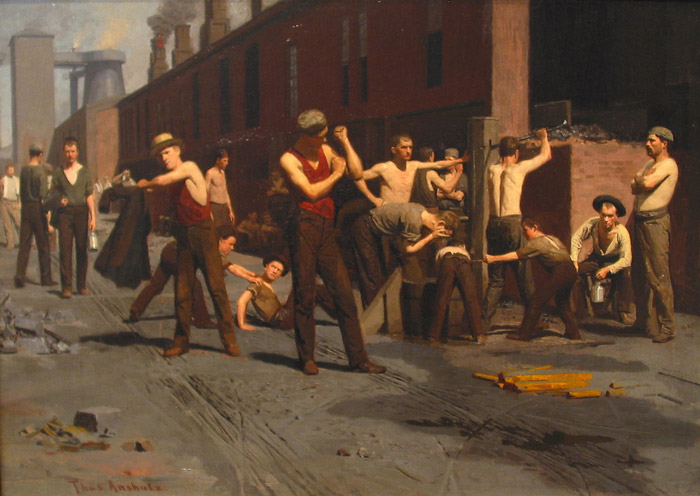 In 1881, this painting earned Thomas Anshutz an award from the local arts establishment, as embodied then by the Philadelphia Sketch Club. The Sketch Club honored Ironworkers' Noontime as the year's "best carefully finished study." According to the minutes from the meeting at which the award was presented, Sketch Club members talked at length about how well Anshutz had learned the style of painting taught by his teacher, club founder Thomas Eakins, and they also talked at length about the painting's extremely unusual subject matter.
In 1881, this painting earned Thomas Anshutz an award from the local arts establishment, as embodied then by the Philadelphia Sketch Club. The Sketch Club honored Ironworkers' Noontime as the year's "best carefully finished study." According to the minutes from the meeting at which the award was presented, Sketch Club members talked at length about how well Anshutz had learned the style of painting taught by his teacher, club founder Thomas Eakins, and they also talked at length about the painting's extremely unusual subject matter.
It's the subject matter that distinguishes the painting today; it's believed to be the earliest American artwork depicting industrial life. Anshutz had been born and raised along the Ohio River near the foundries of Wheeling, West Virginia, where he did the sketches for the painting. He presented the ironworkers as individuals, each using his noon break for his own purposes, despite the overall grime and grit of the surroundings.
The artists in the Sketch Club thought this approach was "needlessly confrontational."
Wheeling's ironworks are now defunct, and the city has been in decline since the 1930s. The old foundry sites along the riverfront are currently promoted for "heritage tourism activities."